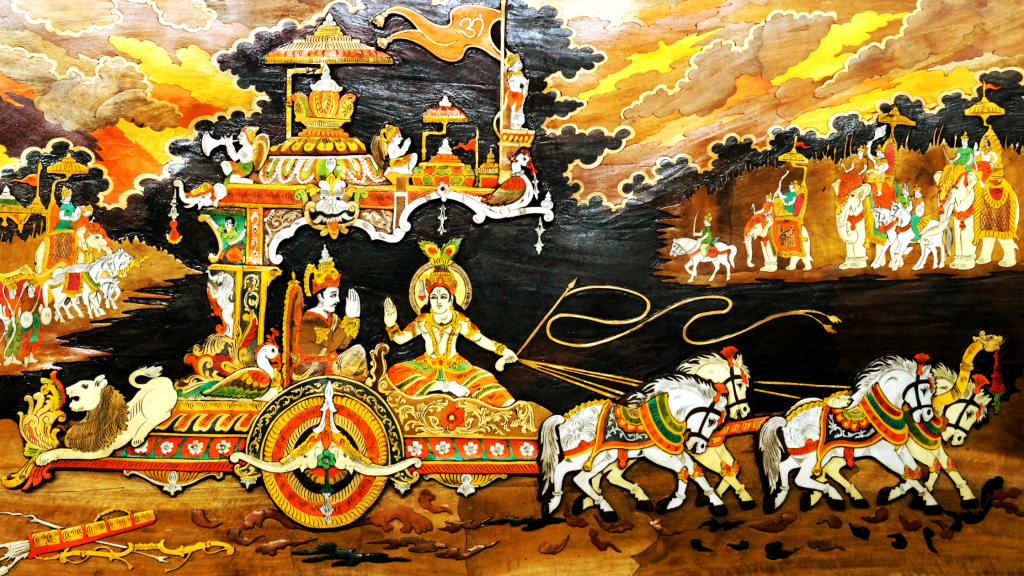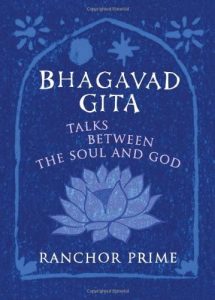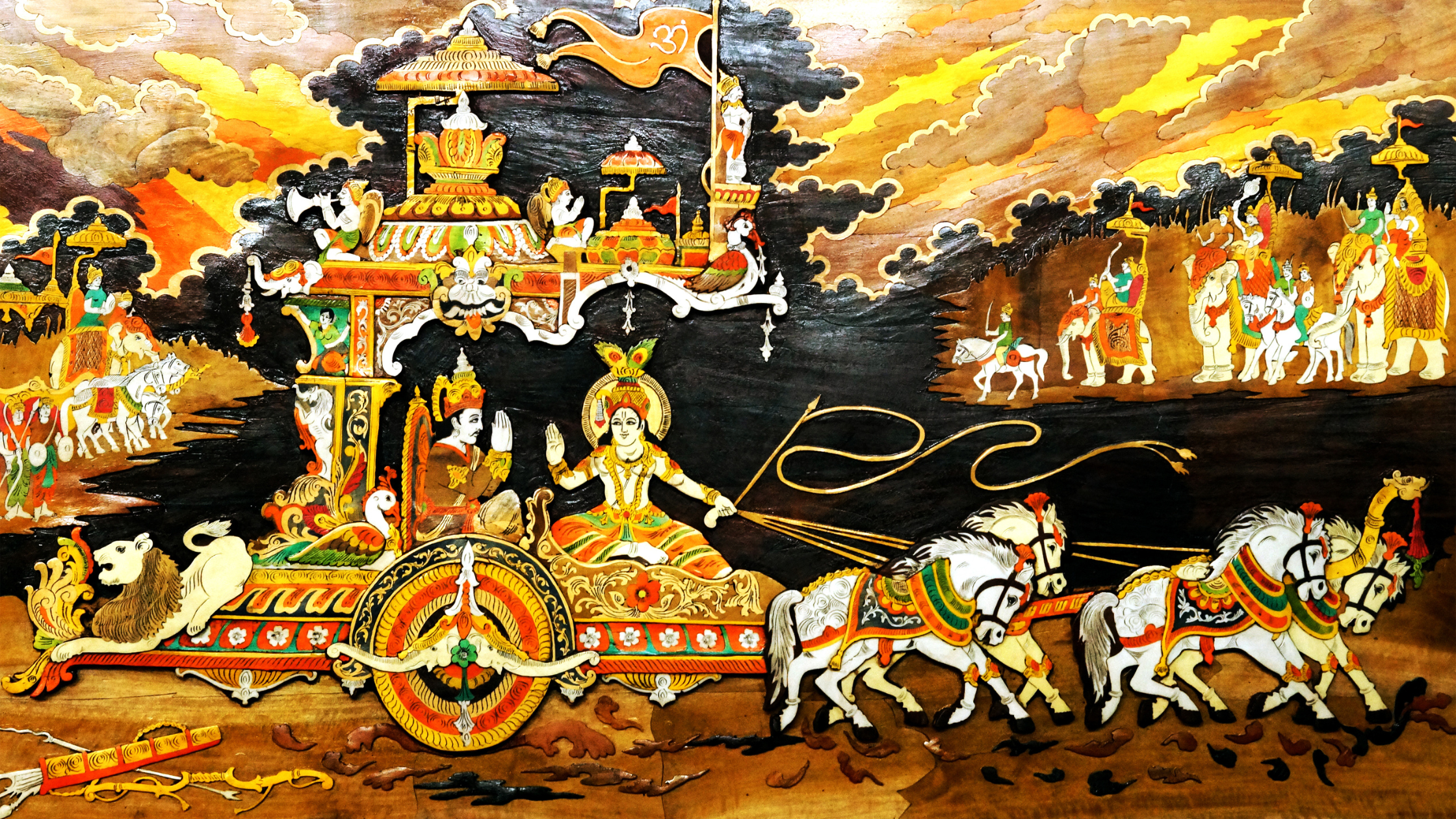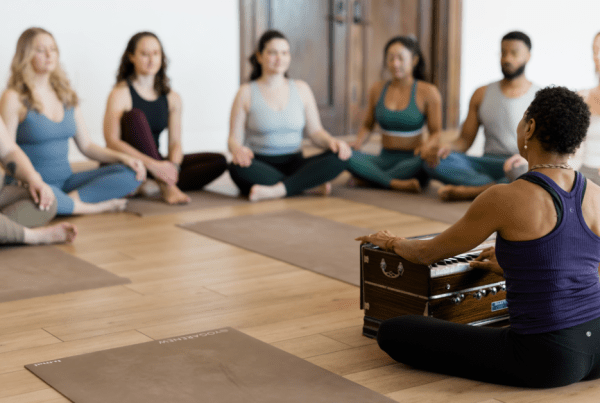
The Bhagavad Gita is a text you may hear yoga teachers talk about, but unless you take the time to study it with a scholar of the text, you probably haven’t given it too much additional thought. At least that’s how it was for me when I first started practicing yoga regularly! I absolutely loved learning about yoga philosophy and learning about how so much of the yogic teachings go beyond the physical practice. When I first read the Bhagavad Gita, I was actually really confused and I didn’t understand how it related to yoga.
I took the time to study this text with different teachers and scholars who helped me unpack and understand its themes and the important messages it shares. I bring this up because I’ve seen so many people pick up a copy of Bhagavad Gita, read it, and walk away without fully understanding its messages. If you happen to find yourself in that situation, I encourage you to seek out classes and teachers who can help you unpack its messages. Hopefully, the information you find here can spark your interest or even clarify some questions you might already have.
As yoga teachers and practitioners of yoga, we eventually begin to seek guidance that transcends the physical aspects of yoga, and search for more ways to understand our mind and our soul. The Bhagavad Gita, an ancient Indian text which is a part of the larger epic of the Mahabharata, provides some of this guidance. It is made up of a dialogue between Arjuna, a warrior, and Lord Krishna, who serves as his charioteer and best friend. This conversation, set against the backdrop of a battle, can be unpacked as a way for us to understand and analyze the internal struggles we all face in our journey through life.
A Reflection of Our Inner Battles

One of the battles depicted from the Bhagavad Gita with Krishna as a chariot driver.
The setting of the Bhagavad Gita is significant. It takes place on a battlefield, which symbolizes the constant conflicts we encounter within ourselves, throughout our lives. Arjuna’s reluctance to fight at the beginning of the battle mirrors the hesitations and doubts as we face during the challenges in this lifetime. As humans, we are often faced with doing things we don’t want to do and we sometimes are in a position where if we do nothing, the outcome could be much worse than the present situation. This is rough, but Bhagavad Gita addresses this concept and also offers wisdom on how to exist in this world while simultaneously living a yogic lifestyle and performing the duties needed.
Self-Realization
Bhagavad Gita’s emphasis on understanding the self is at the core of yoga philosophy. Krishna explains to Arjuna that we are all souls, but we have bodies. In this present day, this concept can be understood by comparing our bodies to cars and trucks. The vehicle can take you from place to place, but you’re not that car or truck. In a similar way, we are a soul and we have a body. The body is like a vehicle for the soul. One day, the body will die, but the soul is eternal.
Dharma (Duty) and Yoga Ethics:
Krishna gives Arjuna a really big lesson on the importance of fulfilling dharma. Dharma can be understood as someone’s duty here on earth. Everyone exists for a reason and everyone has a specific purpose during their life. Through the practices of yoga, it may become more and more clear who you are and why you’re here.
I mentioned before that Arjuna didn’t want to take part in the inevitable battle. This is important to note because Arjuana is a warrior and was born to be just that. The start of Bhagavad Gita is the first time in Arjuana’s life where he’s questioning his life purpose and doesn’t want to do what he was born to do. If there was ever a time in your life where you didn’t know if you were doing what you were supposed to or if you questioned your role in your own life, you may be able to relate to Arjuana’s dilemma.
Karma Yoga: The Yoga of Action
The concept of Karma Yoga, or the path of selfless action, is central to Bhagavad Gita’s teachings. Krishna advises Arjuna to perform his duty without attachment to the results. This principle is essential in yoga practice, where the focus is on the act of practicing rather than the end goal. It’s more important to perform an act in the proper mood, without worrying about or seeking a specific outcome.
Bhakti Yoga
Bhakti Yoga, or the yoga of devotion, is eventually introduced. If you’ve ever woken up in the morning and thought “What can I do for the world today?” vs “What can the world do for me?” you’ve already started to scratch the surface of what Bhakti Yoga Is. It can be understood as the path of devotion to a greater, higher good or a greater higher truth.
Jnana Yoga
Bhagavad Gita also explores Jnana Yoga, the path of wisdom and knowledge. Krishna imparts profound spiritual knowledge to Arjuna, much as a yoga teacher imparts knowledge to students. This knowledge goes beyond the physical postures to encompass the understanding of the self, the universe, and the connection between the two.
The Role of the Yoga Teacher
As yoga teachers, it’s important to cultivate qualities of guiding, supporting, and sometimes challenging your students. You may find that you are called to help them navigate not only the physical aspects of yoga but also the emotional and spiritual journey. Your teachings will inspire students to explore their inner worlds, confront their fears, and find their unique path to self-realization. The role of the teacher is an important one and you can see that dynamic played out throughout this beautiful text.
Integrating Bhagavad Gita’s Teachings into Yoga Classes

Throughout your studies of yoga philosophy, you may hear how Bhagavad Gita is one of the most relatable texts because it teaches you how to live a yogic lifestyle while also providing profound wisdom on how to live in this material world. There are a lot of ancient and classical texts that often talk about concepts like renunciation, leaving behind all material items and going into the woods, and constant practices to leave the body and connect to the soul. These concepts aren’t really conducive to the modern times we live in and it can be a bit difficult to navigate ways to incorporate the teachings of yoga into your already busy life.
Tending to your Personal Practice
As yoga teachers, personal practice and study of texts like the Bhagavad Gita are so important. They not only deepen understanding of the soul and the self, but also authentically enrich your teachings. Your journey through the Gita’s verses can become a wellspring of inspiration and wisdom for our students.
Books
As I mentioned before, the text can be a bit confusing and dense during first read, but here are some suggested texts and books to help on your journey:
- “Bhagavad Gita, Talks Between The Soul and God” by Ranchor Prime
- “A Comprehensive Guide to the Bhagavad Gita” by HD Goswami
- “Bhagavad Gita, As it Is” by A.C. Bhaktivendanta Srila Prabhupada
- “Yoga and the Dark Night of the Soul” by Simon Haas
Podcasts
There is also one particular podcast that I feel does a phenomenal job breaking down the ancient text Bhagavad Gita through a modern-world lens:
In today’s world, where yoga is often seen primarily as physical exercise, the Bhagavad Gita reminds us of the deeper dimensions of this practice. It offers a holistic view of yoga as a path to self-realization, ethical living, and spiritual growth. Its teachings encourage readers to view the practice as a journey towards inner harmony, peace, and understanding.
Bhagavad Gita serves as a compass for yoga teachers and practitioners. Its teachings guide readers to navigate the complexities of life with grace, understanding, and balance. As you continue to explore and share this ancient wisdom, remember that each asana, each breath, and each moment of stillness is an opportunity to embody the profound lessons of Bhagavad Gita, finding within them the strength, serenity, and insight to journey through life with an open heart and a clear mind.











